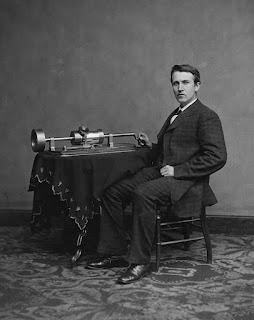“Without music, life would be a blank to me.” — Jane Austen, Emma
Gilded Age entertaining and music went hand in hand. Attending the opera, musicales, or grand balls with a live orchestra was a common social activity for the Gilded Age elite. Live music was also a frequent component of at-home entertaining. When Ruth Mills held a reception for Alice Roosevelt on the occasion of her father's election as President, the Staatsburg Band serenaded her, and the Hungarian Band played music for the evening's dancing.
It was during the Gilded Age, that a whole new way to listen to music was developed. Thomas Edison invented the phonograph in 1877, which was the first generally reliable device to record and play back audio. The sound was fairly scratchy by modern standards, but the technology worked and continually improved over time. The phonograph was a cylinder playing machine, and by the 20th century it was replaced with the disk phonographic record. With this new technology, a machine now existed that could bring recorded music into the home and public spaces.
 |
| Thomas Edison and his second phonograph, 1878 |
 |
| Gramophone, early 1900s |
At Staatsburgh, live music was always readily available due to the Steinway piano in the library. The Mills family could afford to hire a pianist at any time. In addition, daughters Beatrice and Gladys certainly practiced piano since learning to play was standard for young ladies who were educated at home. There is a selection of sheet music for piano in our collection that attests to this fact.
 |
| Beatrice Mills wrote her name in the upper right corner of this piano sheet music that is part of Staatsburgh's collection. |
But did Ruth and Ogden have another musical option when they tired of hearing their children practice? It is possible that they owned an early 20th century model of a phonograph or gramophone, but what was left in the house and what continues to grace the main hall is a Brunswick Panatrope from the late 1920s.
 |
| Brunswick Panatrope in Staatsburgh's Main Hall |
The Brunswick company was founded in 1845 and originally specialized in pool tables, but soon diversified their products. By the 1910s that included phonographs, and soon after, disc phonographic records. In 1920, Brunswick Records released a new line of 78 discs that could be played on their machines. The label recorded many popular musical artists and classical orchestras with a deep roster of jazz artists.
 |
| Under the cover of Staatsburgh's Panatrope |
The Brunswick company started selling the Panatrope in 1925 and it differed from the company's previous phonographs because it was electric. Advertisements lauded the Panatrope's sound quality. The model at Staatsburgh is the P-14, which was first released in 1927. Although the phonograph, and by extension the Panatrope, could bring music to larger audiences, those audiences were still limited. By 1925, only about half of American households had electricity, and of those, even less could afford to spend about $1000 on a non-essential household device.
 | ||
Ad for the Brunswick Panatrope, October 1925
|



Are there any photos of their grand balls?
ReplyDeleteWe wish there were photos of the Mills family attending balls or balls that they hosted, but we haven't found any! There are great period photographs of other Gilded Age balls given by contemporaries of the Mills family.
DeleteNo Wonder I'm Happy (My Baby's in Love with Me)
ReplyDeleteby Radio Franks White and Bessinger Vocal Duet with Piano and Guitar. is available at archive.org, the Internet Archive. The song on the other side of the disc is When Day Is Done.